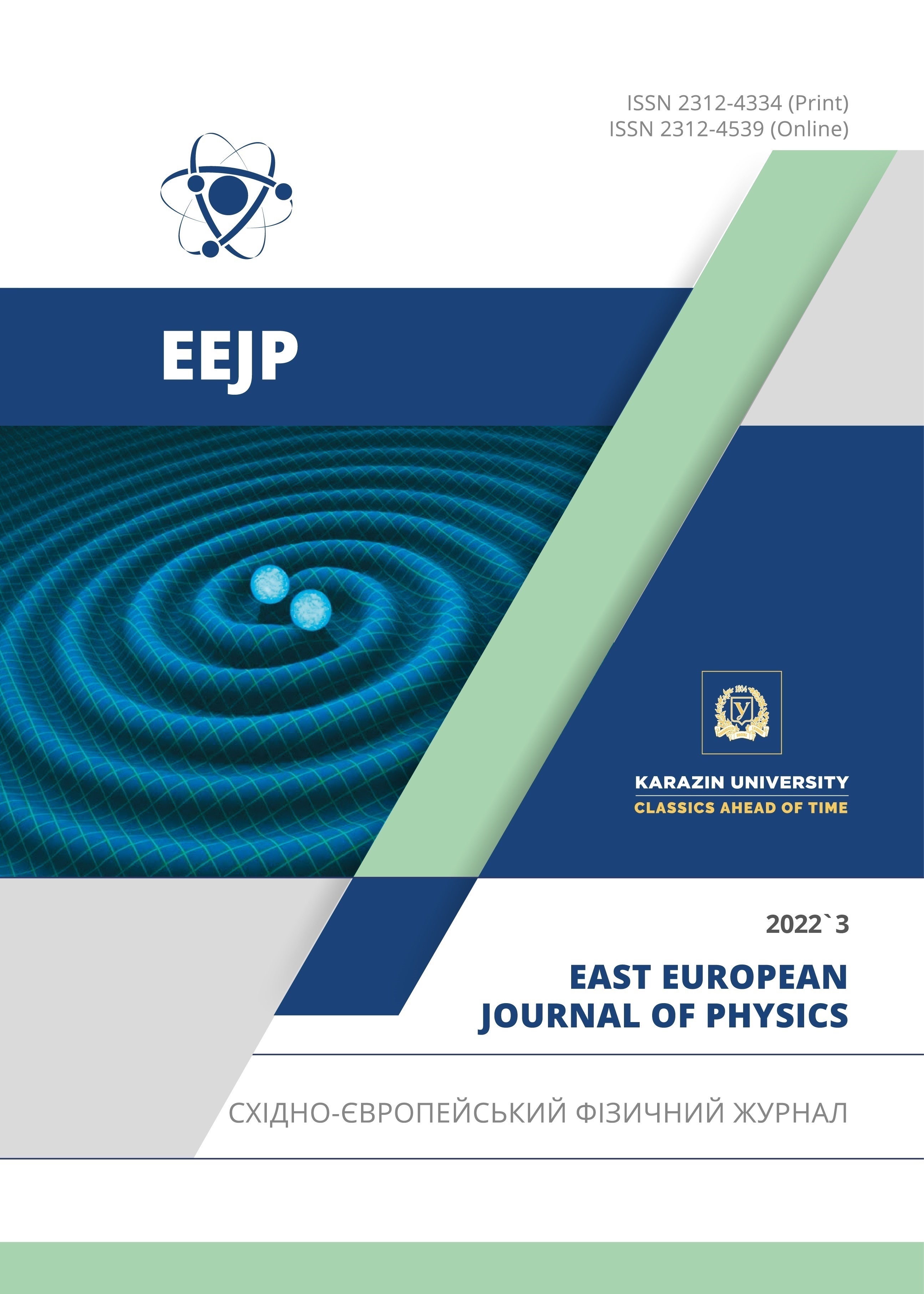Enhanced Performance of CuIn1-xGxSe2 Solar Cell Through Optimization of Absorber and Buffer Layer Properties Using SCAPS-1D
Abstract
This study is a follow up to our previously published article on “Numerical Simulation of Copper Indium Gallium Diselenide Solar Cells Using One Dimensional SCAPS Software”. Five more parameters were optimized which are: absorber band gap, absorber electron affinity, buffer layer band gap, buffer layer electron affinity and working temperature using the same simulation tool initially used. When the absorber bandgap was varied between 0.8 eV and 1.6 eV, the efficiency of the solar cell increases until it reached its peak at 27.81%. This occurred at absorber bandgap of 1.4 eV. Other photovoltaic parameters at this optimum value are: Voc of 1.00 V, Jsc of 31.99 mA/cm2 and FF of 87.47 %. On varying the absorber electron affinity from 4.20 eV through 4.55 eV, we obtained an optimum value of 4.45 eV at Voc of 0.82 V, Jsc of 37.96 mA/cm2, FF of 84.99 % and an efficiency of 26.36%. The optimization of buffer bandgap resulted in an optimal value of 3.0 eV, when the buffer bandgap was varied between 1.6 eV and 3.2 eV. The photovoltaic parameters at this optimal value are: Voc of 0.80 V, Jsc of 37.96 mA/cm2, FF of 85.22 % and an efficiency of 25.86%. The effect of buffer electron affinity was studied by varying its value between 4.00 eV and 4.40 eV and its best value was found to be 4.05 eV at photovoltaic parameters with a Voc of 0.82 V, Jsc of 37.96 mA/cm2, FF of 84.98 % and an efficiency of 26.36 %. These optimized values in all parameters were used to simulate a solar cell which resulted to device with performances: Voc of 1.11 V, Jsc of 31.50 mA/cm2, FF of 88.91 % and an efficiency of 31.11 %. On varying the working temperature on the optimized solar cell, the optimized device with its best performance at 270 K with Photovoltaic (PV) values of Voc of 1.15 V, Jsc of 31.55 mA/cm2, FF of 88.64 % and an efficiency of 32.18%. The results obtained were encouraging and can serve as a guide to those involved in practical development of solar cells.
Downloads
References
O.I. Okoro, and T.C. Madueme, Nigerian Journal of Technology, 23, 58 (2004). https://www.ajol.info/index.php/njt/article/view/123333/112876
B. Padmanabham, Master’s Degree Thesis, Arizona state University (2008).
C.O. Lawani, G.J. Ibeh, O.O. Ige, E. Danladi, J.O. Emmanuel, A.J. Ukwenya, and P.O. Oyedare, Journal of the Nigerian Society of physical Sciences, 3, 48 (2021). https://doi.org/10.46481/jnsps.2021.333
S. Wei, S. Zhang, and A. Zunger, “Effects of Ga addition to CuInSe2on its electronic, structural and defect properties”, Applied Physics letters, 72, 3199, (1998). http://dx.doi.org/10.1063/1.121548
G. Hanna, A. Jasenek, U. Rau, and H.W. Schock, Thin Solid Film, 387, 71 (2001). https://doi.org/10.1016/S0040-6090(00)01710-7
C. Daniella, F. Popescu, P. Joan, and V. Andrei, Procedia-Social and Behavioural Sciences, 191, 512 (2015). https://doi.org/10.1016/j.sbspro.2015.04.284
C. Liu, and W. Liu, Optik, 127, 7359-7366, (2016). https://doi.org/10.1016/j.ijleo.2016.05.045
R. Scheer, and H. Schock, Solar Energy & Photovoltaics, (John Wiley & Sons, Inc., 2011), pp. 384.
Z. Mohammadi, Journal of Fundamental and Applied Sciences, 8, 935 (2016). https://doi.org/10.4314/jfas.v8i3s.114
L. Puyvelde, Doctoral dissertation, Ghent university, Belgium (2015).
A. Sylla, S. Toure, and J. Vilcot, International Journal of Science and Research, 6, 855-860, (2015).
M.I. Hossain, P. Chelvanathan, M. Zaman, M. Karim, M. Alghoul, and N. Amin, Chalcogenide Letters, 8, 315-324, (2011). http://chalcogen.ro/315_Hossain.pdf
M. Green, Eagle Cliffs, (Prentice Hall, 1982).
S. Ruhle, Solar Energy, 130, 139 (2016). https://doi.org/10.1016/j.solener.2016.02.015
P. Jackson, R. Wuerz, D. Hariskos, E. Lotter, W. Witte, and M. Powalla, Physica Status Solidi, 10, 583 (2016). https://doi.org/10.1002/pssr.201600199
P. Jackson, D. Hariskos, R. Wuerz, W. Wischmann, and M. Powalla, Physica Status Solidi, 8, 219-222, (2014). https://doi.org/10.1002/pssr.201409040
ZWS, ZSW-CIGS22Percent-en.pdf (2016). https://www.zsw-bw.de/fileadmin/user_upload/PDFs/Pressemitteilungen/2016/pi07-2016-ZSW-CIGS22Percent-en.pdf
K. Sobayel, K.S. Rahman, M.R. Karim, M.O. Aijaz, M.A. Dar, M.A. Shar, H. Misran, and N. Amin, Chalcogenide Letters, 15, 333-340, (2018). https://chalcogen.ro/307_SobayelK.pdf
M. Green, Progress in Photovoltaic Research and Application 11, 333-340, (2003). https://doi.org/10.1002/pip.496
P. Chelvanatan, M.I. Hossain, and N. Amin, Current applied physics, 10, S387-S391, (2010). https://doi.org/10.1016/j.cap.2010.02.018
Copyright (c) 2022 Godwin J. Ibeh, Celine O. Lawani, Jayeola O. Emmanuel, Peter O. Oyedare, Eli Danladi, Olumide O. Ige

This work is licensed under a Creative Commons Attribution 4.0 International License.
Authors who publish with this journal agree to the following terms:
- Authors retain copyright and grant the journal right of first publication with the work simultaneously licensed under a Creative Commons Attribution License that allows others to share the work with an acknowledgment of the work's authorship and initial publication in this journal.
- Authors are able to enter into separate, additional contractual arrangements for the non-exclusive distribution of the journal's published version of the work (e.g., post it to an institutional repository or publish it in a book), with an acknowledgment of its initial publication in this journal.
- Authors are permitted and encouraged to post their work online (e.g., in institutional repositories or on their website) prior to and during the submission process, as it can lead to productive exchanges, as well as earlier and greater citation of published work (See The Effect of Open Access).








